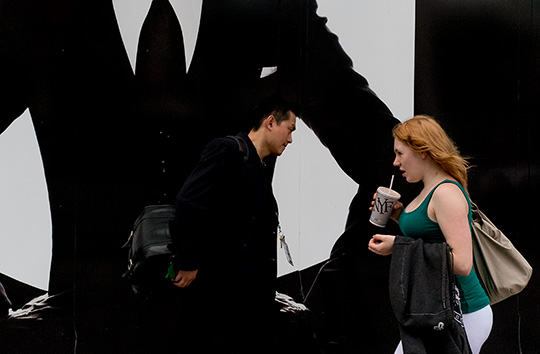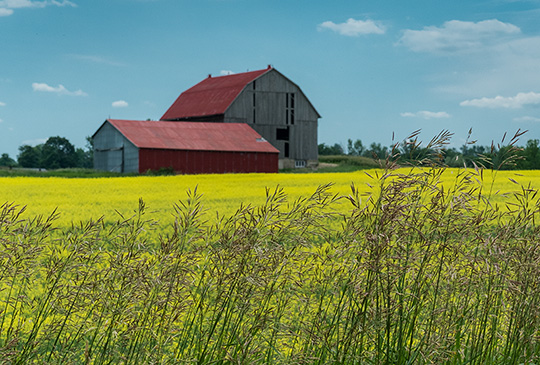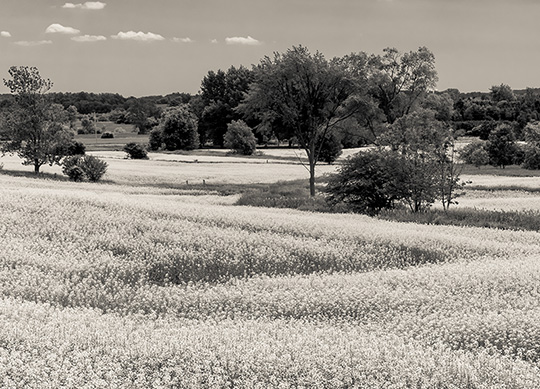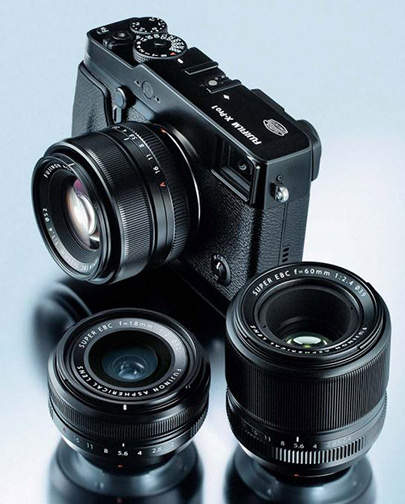
For a variety of reasons I was unable to review theFuji X-Pro 1when it came out in January, 2012. Among these was that I was in Mexico at the time and working on other projects. My colleagueNick Devlin had my proxy and wrote a couple of user reviews;Part 1andPart 2are found here.
But now, six months later, my schedule cleared a bit and I was eager to try the X-Pro 1 for myself. A brief business trip to New York seemed like an appropriate venue for some impromptu street shooting (what this camera was designed for), and so I picked up a loaner and three lenses just before departure. I continued to work with the camera for the next week or so to ensure that I became fully familiar with it. This is very much a landmark camera, with strong competitors already on the market; theSony NEX-7and theOlympus OM-D E-M5in particular and several more are coming down the pike this fall. I therefore felt it was important that I get the full measure of this latest Fuji. Thanks to Fujifilm Canada for making equipment available for my testing.
Impatient. Toronto, June, 2012
Fuji X-Pro 1 with XF-35mm f/1.4R @ ISO 3200
The Basics
My first impression was that the camera is bigger than it looks. I have been using theFuji X-100for some time, and because of their superficial similarity had imagined something similar. That’s not the case. The X-Pro 1 is a significantly larger camera than the X-100, or its current top competitors the Sony NEX-7 and Olympus O-MD. Indeed the Fuji is similar in size to the full-frame Leica M9, which is of course the Fuji’s spiritual inspiration. But, compared to the M9 which hefts as if it was carved from a solid block ofUnobtainium, the X-Pro 1 is noticeably lighter.
In terms of its core design the Fuji is bound to delight the traditionalist. There is noModedial. The camera doesn’t need one. This is because there is a standard shutter speed dial and also a traditional aperture ring. Both of these also have “A” positions. When set this puts that control in Auto mode. Both set means full Program mode. This isn’t the first time we’ve seen this design conceit, but whenever a manufacturer adopts it I smile, because for the photographer that wants full control of their camera, yet also enjoys selecting a level of automation when needed, this approach works well. It also has a pleasurable tactility that’s missing on cameras with only modal wheels and touch screens.
The fit and finish on the X-Pro 1 is first rate. Unlike some current cameras which sometimes push the “smaller is better” envelope to extremes, the new Fuji doesn’t insult ones fingers with buttons and controls designed for Lilliputians.
There is also a traditional style exposure compensation wheel where ones right thumb rests, and it has firm clickstops that are unlikely to be accidentally moved. Below it is aQuick button which calls up a one screen summary of major camera functions, making for easy access to most needed functions. There is also a rear scroll wheel with push-to-set. Overall the manual control settings are straightforward. There is a single custom function button next to the shutter release that if set to ISO completes a logical external user-oriented control interface.
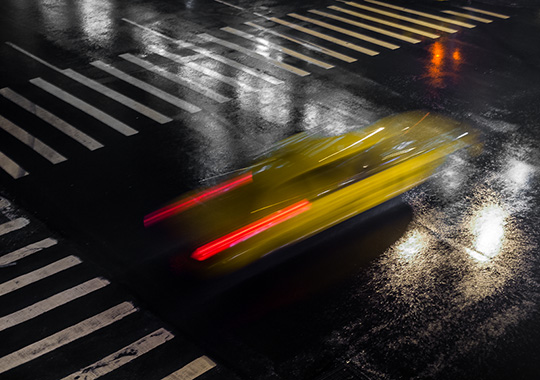
Yellow Cab. New York, NY. June, 2012
Fuji X-Pro 1 with XF 35mm f/1.4R @ ISO 500
The EVF/ Viewfinder
Because this isn’t a review per-se, but rather a personal first-impressions style report, I won’t belabor a discussion of the camera’s unique combination optical and electronic viewfinder. The concept is that it’s two viewfinders in one; an optical window finder similar to that on an M Leica and an EVF like those on other mirrorless cameras.
The concept works well. Some people like optical window finders and the ability to see outside of the box, so to speak. Others prefer the directness of an EVF. One aspect of the window finder that is appreciated is that there is a transparent LCD overlay that allows shooting data to be displayed as an overlay on the view. It also serves to display the framing outline and focus box of the lens in use, something that on a Leica is accomplished with a complex optical window projection.
The X-Pro 1 is able to vary the magnification of the window finder to accommodate different focal length lenses, but there are only two magnifications, and with the 60mm lens attached one is still looking at quite a bit more than the captured area.
There are stepped focus point rectangles to indicate paralax compensated positions, and the actual focus point will move in relation to these as the lens focuses close. If you’re a window finder kind of shooter this will appeal.
My concerns with the EVF / Window finder is two-fold. Firstly, there is no adjustable eyepiece diopter and secondly the EVF refresh rate is too slow, making for blurred pans and moving subjects in the display. Both are serious concerns.
Autofocus
Much has been made of the X-Pro 1’s autofocus speed, or lack of it. That has not been my experience. Maybe it’s because I started using the camera with the latest firmware update, but reports of lethargic AF are not in line with my experience. Subjectively I find AF speed with the 35mm f/1.4 to be fine, and also with the 18mm f/2. The 60mm f/2.4 Macro is noticeably slower, but not at all terrible.
What I did find though was that I never could quite trust that what the AF rectangle was centered on would in fact be what the camera focused on. This is particularly true if the subject behind the main point of focus is brighter and more contrasty than a foreground subject.
Red Barn. Clearview, Ontario. June, 2012
Fuji X-Pro 1 with XF 60mm f/2.4R Macro @ ISO 800
Lenses
The three primes that are currently available for the X-Pro 1 will be followed eventually by some zooms. These will obviously only work with the camera’s LCD and EVF, not the window finder.
Each of the three current lenses is in my experience quite good, especially the 35mm f/1.4, and especially for the money. The 60mm Macro is also excellent, but the 18mm WA tens to softness at the corners and edges, especially wide open. Fujifilm definitely knows how to make fine lenses, and they don’t cost an arm and a leg either.
The Goods
There’s an awful lot to like about the X-Pro 1. Image quality is potentially nothing short of excellent. High ISOs (up to and including 3200) are as clean as anything from the competition, and because the camera lacks an anti-aliasing filter, and the lenses are so sharp, few will find image quality lacking.
If you are an aficionado of window focusing cameras (ie: the Leica M8 and M9) and are looking for something a bit less expensive (actually a lot less expensive) and with autofocus lenses available, then look no further than the X-Pro 1. You also get a built-in EVF for when you want one. Of course the rear LCD is always available (though not articulated).
There’s something very satisfying about the handling of the X-Pro 1. There isn’t quite enough of a thumb grip or front finger purchase (there is an optional grip available), but overall the “feel” of the camera is very appealing.
The Not so Goods
As good as the X-Pro 1 is, and it is very good in most respects, there are some things that annoy and others that are downright frustrating. When the camera first shipped there were some issues (chattering aperture, for example) that required urgent remediation.
Here then, in no particular order are the things that concern me about the Fuji X-Pro 1…
– no lens-based or in body image stabilization
– no eyepiece diopter adjustment and insufficient eye relief when wearing glass
– no instant review histogram available
– slow card write speeds; quite a bit slower than either the NEX-7 or OM-D
– no control of minimum shutter speed in Auto-ISO
– the EVF refresh rate is too low, and when panning the camera or with rapidly moving subjects there is a lot of blur
– the “A” position on the lenses does not lock and it’s consequently all too easy to find oneself shooting at f/16 unintentionally
– the throw on the shutter release is longer than it could be. It takes too deep a first press until AF engages
– the SD card is hard to get at. As on most compact system cameras (the OM-D excepted) Fuji puts the SD card slot together with the battery. Unless one has tiny fingers it can be very hard to extract the card from its recess.
– the camera’s video controls and capabilities are limited
Something that needs to be discussed in some depth is a concern that some users may have when manual focusing. The X-Pro 1 does no allow you to focus with the lens wide open, even if you’ve set the aperture ring to the lens’ maximum aperture. It feels like a manual aperture ring, but it’s really fly-by-wire.
The reason is that the camera wants to control the aperture, regardless of the lens setting, so that its LCD and EVF image have an appropriate brightness. That’s what the so-called “chattering” was about before the firmware upgrade. The upgrade fixed the chattering sounds but it didn’t address the underlying issue, that the user can not actually focus the camera manually at a selected F stop, which means that you can’t properly preview Depth of Field. Of course the camera will change the aperture to whatever you’ve set when you actually take the shot, but not when framing and focusing manually. The Leica X-1 had the same issue when it was first released but Leica subsequently corrected this with a firmware update.
Summer Snow. Clearview, Ontario. June, 2012
Fuji X-Pro 1 with XF 60mm f/2.4R Macro @ ISO 200
Use with Legacy and Third Party Lenses
Like almost all mirrorless interchangeable lens cameras with short register distances, the X-Pro 1 is able to take a huge variety of legacy third party lenses. Fuji even makes a Leica M lens adaptor of their own, though third party adaptors are available.
I did some shooting with several of my M Leica and Leica mount lenses, including the Voigtlander 12mm. The camera works fine with these lenses, and pressing in on the control wheel offers focus magnification on both the EVF and LCD. But because of the high fixed magnification size, low refresh rate, strong rolling shutter effect and lack of peaking, this isn’t the most pleasurable way of working.
Something to be aware of is that the camera allows setting of custom frame lines in the window finder via the menus. The only kink I found (thanks Sean for the heads up) is that with third party adaptors (I used a Kipon) the “illuminated” frame lines are quite dim when used in bright daylight. This is not the case when Fuji lenses are mounted. I am told that use of the Fuji branded M adaptor may address this, but I was unable to test one myself to this point.
UPDATE: Regrettably this turns out not to be the case. The Fuji adaptor does not allow for illuminated frame lines. This means that this is a bug, and makes me wonder if anyone at Fuji ever actually put an M lens on the camera and when outdoors to take a picture.
What you’ll see with these lenses is that results are generally fine, but as with most mirrorless cameras there has not been any attempt by Fuji to design sensor microlenses specifically for legacy glass. The only cameras that do so are the Leica M9 itself and the Ricoh M Mount A12. And Fuji shouldn’t have to, because after all Fuji’s own WA lens is a retrofocus design and don’t need this. Of course this means that while many M mount lenses will work fine, beware of symmetrical designs such as some of the Zeiss and Voigtlanders. You’ll find soft corners and strong vignetting.
In the end, someone with a collection of legacy lenses, particularly Leica M glass, will find no particular advantage to working with the X-Pro 1 over any other mirrorless camera. The window finder can’t be used effectively with non-Fuji lenses, and the EVF and focusing aids are no better and in some cases not as good as what’s available from other marques. Sean Reid discusses this in considerable detail on his subscription siteReid Reviews.
Raw Conversion
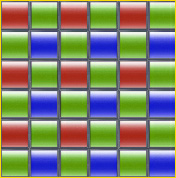 |
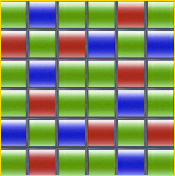 |
The X-Pro 1 uses a unique colour matrix which Fuji calls X-Trans. Rather than the traditional Bayer style matrix, X-Trans alternates colour pixel in a quasi-random manner and also increases the ratio of green to red and blue pixels. The net of this is supposed to be superior colour rendition and the avoidance of colour aliasing as a result of the camera not have an AA filter.
Without debating the merits of this proprietary technology, what we do see is that it is proving difficult for raw processing programs to do the best possible job of decoding these files. SilkyPix is provided by Fuji, and some users have concerns about how it handles X-Pro 1 files in terms of “mottling”. Recently Adobe added support via Lightroom 4.1 and Camera Raw 7.1, but there are reports by critical observers that it too isn’t as finessed as it might be, displaying some chroma smearing . You may want to readthis article by Sandy McGuffog for more on the topic, andalso this one. An essay titled Four Window Finder Camerason Sean Reid’s subscription site is a must-read for anyone interested in a detailed evaluation of the X-Pro 1, both operationally and in terms of image quality.
I don’t have enough experience with X-Pro 1 raw files to make my own firm judgements on this, but I respect some of the observers that have reported concerns to me, so I’ll just pass these along as uncorroborated at this time.
Compared to the Competition
Feature comparisons can be a bit lame. Cameras have overall strengths and weaknesses that may or may not be particularly relevant to any given photographer. But, having this kind of comparative information in tabular form can sometimes be informative and useful.
In the chart below I have mostly not listed items that are common to all three cameras. Only where one or two have something and the other doesn’t do I draw attention to it. Which ones might matter to you is your call.
Fuji X-Pro 1
Olympus OM-D E-M5
Sony NEX-7
Image Stabilization
N
Y
Y
Stabilization with all lenses
N
Y
N
Image Audio Note Recording
N
Y
N
Instant Review Histogram
N
Y
Y
Articulated LCD
N
Y
Y
Built in EVF
Y
Y
Y
Optical Window Finder
Y
N
N
Focus Peaking
N
N
Y
Touch Screen
N
Y
N
Seperate Card Door
N
Y
N
Weather Sealed
N
Y
N
Optional Vertical Grip
N
Y
N
External Dial Shutter & Aperture Controls
Y
N
N
Eye Piece Diopter Adjustment
N
Y
Y
Built in Flash
N
N – included accessory
Y
The Bottom Line
Whereas the digital revolution caught Kodak flat-footed, Fujifilm has managed to roll with the punches. Their foray into DSLRs was hampered by needing Nikon as a body supplier, and when that relationship came to an end it looked like Fuji would be left with just digicams. But Fuji has a history of designing and manufacturing both excellent cameras and lenses. The Hasselblad X-Pan as but one example, and their large format and broadcast TV lenses are legendary.
With the introduction of theX-100in 2011 and its enthusiastic reception worldwide it was clear that Fuji was onto something. So-called Mirrorless System Cameras are the new marketplace hot prospect, and using the X-100 as a design springboard the company has entered this new market with a strong competitor that isn’t just a me-to offering. Serious photographers looking for an alternative to bulky DSLRs but who are unwilling to compromise on image quality are finding the X-Pro 1 and its competitors highly attractive. This is becoming a very fast track though, with both Sony and Olympus taking the high-ground, at least for the time-being. Panasonic will undoubtedly have a new high-end offering later this year and Canon has yet to be heard from, though no doubt with a strong entry on its way shortly.
Fuji is on the right track with the X-Pro series and not with just a me-too offering. But there are enough annoyances with the X-100 and X-Pro 1 that Fuji needs to appreciate the need for sweating the details when it comes to product execution. Their designs are brilliant, build quality is very high, and optical quality second to none. Now they just need to refine their functional execution to have class-leading products.
June, 2012
You May Also Enjoy...
EOS-1D
Canon EOS-1D Canon's Pro Digital SLR October 6, 2001 I had an opportunity yesterday to spend some time handling a pre-production sample of
Mounting Prints on Aluminium Composite
IntroductionDuring a visit to Northern Germany last November I attended a local painting and photography exhibition in Hamburg featuring the works of area artists and
